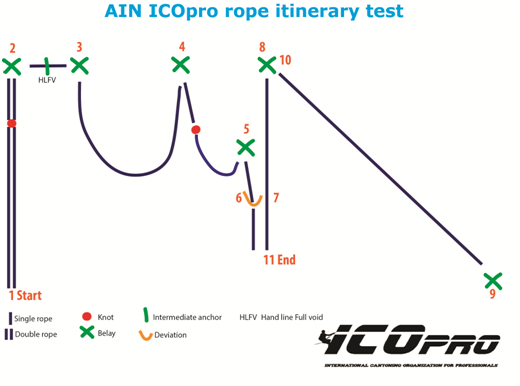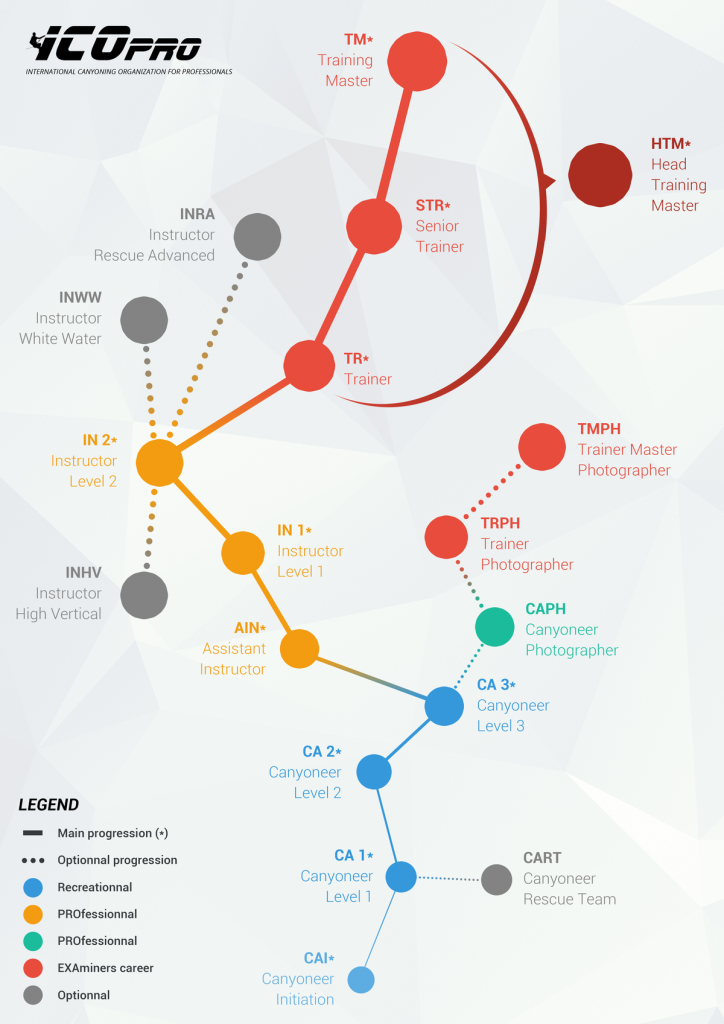Did you make up your mind to launch your professional career? You aim at improving your technical skills for canyoning descents? The Assistant Instructor training course will have a significant impact on your professional goal since you will gain advanced professional technical abilities.
To choose an AIN course and an appropriate date, check the Training Course Schedule or contact one of our ICOpro centers or send an email to ICOpro support:
You will be trained by an ICOpro Examiner (Trainer level minimum), and will get certified at the end of the course thanks to the Instructor Card.
A couple of months after you got certified, you will receive by mail your professional card including a one-year free licence and your certificate.
Duration: 12 days
- Pre-training course e-learning: 2 days minimum
- Assistant Instructor Training Course: 10 days
Prerequisite
- Available for everyone who has reached the age of the majority in his/her country of origin.
- Have validated CA Lvl 3 or have attended ICOpro IEC/IVS.
- Have completed AIN e-learning pre-training course.
- Be in good mental and physical condition.
- Swimming: 50m and running: 1km.
- Medical certificate issued less than three months prior to the training course, testifying that the trainee is physically and mentally fit for canyoning activities.
- Have a valid first-aid certificate issued less than twelve months prior to the training course
- Pass successfully the entry test 1:« AIN test of conversion » on single rope free method in a time less than or equal to 5mn. High 5m, knot in a middle of the rope
Ascent → Passing a knot → Conversion → Descent → Passing a knot. Or
Descent → Passing a knot → Conversion → Ascent → Passing a knot!!! The candidate will not attend the training if the test is not successful and no refunds will be given. - Pass successfully the entry test 2 « AIN Rescue Scenario » Indirect rope cutting free method in a time less than or equal to 1.15mn.!!! The candidate will not attend the training if the test is not successful and no refunds will be given.
Objective
Have all the required skills to assist an ICOpro Instructor (IN) during Canyoneer Initiation training course (CAI) and to assist the IN to manage the logistics of an ICOpro Affiliated Center. The Assistant Instructor helps the IN who is in charge of the excursion; and the AIN must also be skilled enough to supervise the group in case of accident or force majeure.
Organization
The training consists in 6 technical and theoretical teaching modules, including analyzing exercises and evaluations (P.A.R), aptitude memory exercise (Feedback) that will be carried-out during the training and 4 Clinic Days of revision and regulation.
- Module 1: Procedures – General knowledge
- Module 2: Whitewater – Assistance
- Module 3: Vertical progression
- Module 4: Set-up – Rescue
- Module 5: ICOpro Psychology – Pedagogy
- Module 6: End of the ICTC AIN
Clinics
- Regulation 1: Set-up – Progression
- Regulation 2: Rescue scenario
- Regulation 3 & 4: CAI
Certifications
- Entry technical test 1: AIN test of converstion
- Entry technical test 2: Resque Scenario : Indirect rope cutting
- Theory test 1: CA1 Physic: 10 questions
- Theory test 2: CA3 Anchors: 10 questions
- Theory test 3: CA2 Assistance: 10 questions
- Theory test 4: AIN General: 70 questions
- Final technical test 1: AIN’s rope itinerary
- Final technical test 2: Rescue Scenario: Counter weight
Module 1: ICOpro Procedures – General Knowledge
Day 1: Classroom session
1A. ICTC/AIN
- Entry tests
- Content
- Daily Program
- Evaluation
1B. ICOpro
- E-learning: ICOpro professional framework Lvl1
- E-learning: ICOpro IAI & CTR Lvl1
- E-learning: ICOpro Quality Control
- E-learning: AIN definition and duties
- E-learning: AIN ICOpro standards
- E-learning: AIN licence and affiliation
- E-learning: CAI participant record
- E-learning: ICOpro Professional Charter
- E-learning: ICOpro Assistant Instructor web portal
- Feedback CA1: ICOpro PPE Software
1C. Canyoning equipment
- E-learning: ICOpro PPE verification Lvl 2
- E-learning: AIN additional equipment
1D. Knots Lvl2
- Feedback CA1: The different knots
- E-learning: AIN additional knots
1E. Physics
- Theory test 1 CA1: Fall factor and impact force
1F. Anchors Lvl2
- Theory test 2 CA3: Identification
- E-learning: Operating principle
1G. Physiology
- Feedback CA1: Basics of sport physiology
- Feedback CA1: Stretching theory and practise
1H. Feedback, test and monitoring
- Evaluation end of day 1
- Check monitoring program of day 1
Module 2: Whitewater – Assistance
Day 2: canyon or river session
2A. Physiology
- Stretching
2B. Free-diving Lvl2
- E-learning: Advanced complete breathing
- Advanced static apnea
- Basic dynamic apnea
- Duck diving up to 5m
- Advanced black out knowlegde
2C. Assistance Lvl3
- Feedback CA2: Participant assessment
- Intervention jump
- Drag participant in white water
- Throwing the rope
- Feedback CA2: Transporting a victim, Tragsitz method
- E-learning: Limbs and vertebral column traumatology
- E-learning: Transporting a victim: Improvised stretcher method
- E-learning: Advanced recovery positions
- E-learning: Collective warm point
- Feedback CA2: Rescue alert
2D. White water Lvl4
- Pendulum assistance
- Aquatic guide on anchor
- Progression in white water (max a4)
2E. Feedback, test and monitoring
- Theory test 3 CA: First-aid kit and rescue alert
- Evaluation end of day 2
- Self-assessment day 1&2
- Check monitoring program of day 2
Module 3: Vertical Progression
Day 3: Cliff or Training wall session
3B. Horizontal rope progression: Hand-lines Lvl3
- Full void with intermediate points
3C. Vertical rope progression: Descent Lvl3
- Pass a knot on double rope
3D. Vertical rope progression: Ascent Lvl2
- Ascent on double rope
- P.A.R: Pass a knot on double
- Ascent on guide line
3E. Vertical rope progression: Conversion Lvl2
- P.A.R: Conversion on double rope
- P.A.R: IN1 test of conversion on double rope
3F. Improvised technique
- P.A.R: Descent on single and double rope and lock-off
- Ascent on single rope
- P.A.R: Ascent on single rope
- P.A.R: AIN test of conversion on single rope
- Limits of self-belaying while rappelling
3G. Rock climbing Lvl2
- Feedback CA3: Leader Progression
- Feedback CA3: Teammates progression
- P.A.R: Set-up within adventurous environment
3H. Feedback, test and monitoring
- Evaluation end of day 3
- Check monitoring program of day 3
Module 4: Set-Up – Rescue
Day 4: Cliff or Training wall session
4A. Physiology
- Running
- Breathing
- Stretching
4B. Set-up: ICOpro Professional philosophy
- E-learning: Rope optimization understanding
- E-learning: Set-up optimization
a. Fixed
b. Releasable
4C. Set-up: hand-lines Lvl2
- Fixed with intermediate point
- Retrievable with intermediate point
a. Self-belaying
b. Belaying a teammate
4D. Set-up: verticals Lvl2
- Feedback CA3: Releasable systems
- P.A.R: Releasable technique from below
- Rebelays
4E. Set-up: guided rappel Lvl2
- Fixed system from below with Figure of eight in Italian position
a. With auxiliary rope
b. Without auxiliary rope
4F. Rescue scenario Lvl2
- Counter weight with auxiliary rope & Progress Capture Pulley (PCP)
- Rescue a stuck victim with balancier from below to below
a. Conscious
b. Unconscious - Rope cutting from below
4G. Feedback, test and monitoring
- Evaluation end of day 4
- Self-assessment day 3&4
- Check monitoring program of day 4
Clinic 1 & 2: Set-up – Progression – Rescue
Day 5-6: Canyon session
Physiology
- Stretching
Clinics objectives
- Regulate the skills of the candidate
- Checking and validating the skills previously taught during the course
Description of the regulation
- The future Assistant Instructor shall be available for the Instructor and shall demonstrate his/her competences in ensuring the set-up – Progression (clinic 1) and rescue scenario (clinic 2)
As an Assistant Instructor, he/she will demonstrate his/her quick wit, and situation analysis (P.A.R)
Feedback
- Regulation of each clinic
Module 5: ICOpro Psychology – Pedagogy – Theoretical Test
Day 7: Classroom session
5A. Psychology Lvl1
- The 5 fundamental needs
- The mind and new environment
- CAI fear and stress
- The AIN Level of stress
- The Mirror effect
- The Rosenthal effect
- The privacy area
5B. Pedagogy Lvl1
- Behaving as a Professional
- Autonomy of CAI
- CAI’s equipment
- Proficient Analytical Resources® (P.A.R)
5C. Theory test 4 AIN general
Written test: 70 multiple choice questions about the Assistant Instructor’s curriculum. 80% positive answer of the 70 questions is needed to pass the theory test (maximum mistakes authorized: 14). Test duration: 70 min.
5D. Feedback, test and monitoring
- Evaluation end of day 7
- Self-assessment day 5-6-7
- Check monitoring program of day 5-6-7
Clinic 3&4: CAI
Day 8-9: Canyon session
Physology
- Stretching
Clinics objectives
- Regulate the skills of the candidate
- Checking and validating the skills previously taught during the course
Description of the regulation
- The future Assistant Instructor shall be available for the Instructor and shall demonstrate his/her competences in ensuring the security and leading the team while running CAI training.
- As an Assistant Instructor, he/she will demonstrate his/her management and team leading skills previously taught as follows:
a. Welcome and CAI’s equipment
b. Easy and dynamic progression, ensuring his/her individual and collective safety;
c. Good position according to the belay and obstacle configuration;
d. Helping, advising, reassuring, supporting and reprimanding;
e. Meeting the Instructor’s requests;
f. Fulfilling the Assistant Instructor’s duties;
g. Reinvesting every educational pedagogical and psychological basic knowledge previously taught during
the course.
Feedback and monitoring
- Regulation of each clinic
- Self-assessment day 8&9
- Check monitoring program of day 8&9
Technical Test 1: Rope Itinerary
Day 10: Cliff, Canyon or Training wall session
Every technique must be, by default, executed on single rope, unless « doubled rope » specified.
The ropes used for the tests must have a diameter between 9 and 10mm.
Perform the « AIN’s rope itinerary » within a time equal or inferior to 1.7 times than that of the examiner’s time.
– Ascending on doubled rope
– Passing a belay
– Progressing on handline, full void
– Rappelling in loop figure, then ascending on the other side
– Passing a knot while descending
– Passing a rebelay
– Passing a deviation
– Conversion – change of rope
– Descending on a guide line with improvised technique on a descender
– Ascending on a guide
– Rappelling with improvised technique

Technical Test 2: Rescue Scenario: counter weight
Day 10: Cliff, Canyon or Training wall session +/- 5mn per candidates
The ropes used for the tests must have a diameter between 9 and 10mm.
- The workshop: The test will take place vertically, full, empty or against the wall, height between 5 and 7 meters.
- Scenario: The AIN has just climbed a vertical section during the set up of an escape route. He/she has to get his/her group to climb but one of the canyoneer CAI is not able to climb the obstacle. The AIN is on top of the obstacle, connected to a belay anchor. He/she has at his/her disposal a rope, which length is at least equal to the height of the obstacle, as well as his/her personal equipment. The canyoneer is standing at the bottom of the obstacle, conscious and within earshot. The canyoneer is inactive during the operation, besides managing his/her own comfort and balance. The AIN must remain connected to the anchor throughout the maneuver.
Module 6: Closing of the ICTC AIN
6A. Validation
- Tests results
- Personal feedback and shadowing
- Validation of participant
- General feedback
6B. ICOpro Next step
- Presentation of ICTC IN1
- Advantage to be IN1
We wish you a pleasant training course!
Canyoning is what we do
Get ICOpro certified



